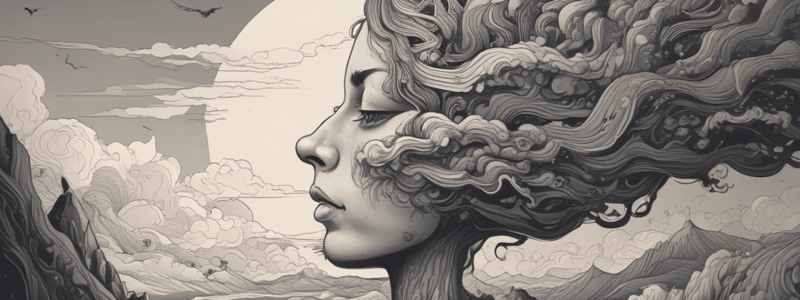Podcast
Questions and Answers
What is the primary difference between a depressive episode and a depressive disorder?
What is the primary difference between a depressive episode and a depressive disorder?
- Type of mood experienced
- Intensity of the symptoms
- Impact on daily life and social functioning (correct)
- Duration of the episode
Which of the following is NOT a characteristic of mood disorders?
Which of the following is NOT a characteristic of mood disorders?
- Temporary and fleeting nature of symptoms (correct)
- Extended periods of depressed or euphoric mood
- Significant distress and interference with daily life
- Social and occupational difficulties
What is the primary difference between major depressive disorder and persistent depressive disorder?
What is the primary difference between major depressive disorder and persistent depressive disorder?
- Presence of manic or hypomanic episodes (correct)
- Number of depressive episodes
- Duration of depressive episodes
- Intensity of depressive symptoms
What is the purpose of this section of the text?
What is the purpose of this section of the text?
What is the term for a mood disorder characterized by only the depressive pole?
What is the term for a mood disorder characterized by only the depressive pole?
According to the DSM-5-TR, which of the following is a type of unipolar depression?
According to the DSM-5-TR, which of the following is a type of unipolar depression?
What is the term for a period of depressed, euphoric, or irritable mood that causes significant distress and interference with daily life?
What is the term for a period of depressed, euphoric, or irritable mood that causes significant distress and interference with daily life?
Which of the following is a risk factor for the development of mood disorders?
Which of the following is a risk factor for the development of mood disorders?
What is the purpose of reviewing biological and environmental risk factors in the context of mood disorders?
What is the purpose of reviewing biological and environmental risk factors in the context of mood disorders?
What is the primary focus of this section of the text in terms of treatment?
What is the primary focus of this section of the text in terms of treatment?
What is the minimum number of symptoms required to meet the diagnostic criteria for major depressive disorder?
What is the minimum number of symptoms required to meet the diagnostic criteria for major depressive disorder?
What is the duration of the symptoms required to meet the diagnostic criteria for persistent depressive disorder?
What is the duration of the symptoms required to meet the diagnostic criteria for persistent depressive disorder?
Which of the following symptoms is NOT required to meet the diagnostic criteria for major depressive disorder?
Which of the following symptoms is NOT required to meet the diagnostic criteria for major depressive disorder?
What is the lifetime prevalence rate for major depressive disorder in the general population?
What is the lifetime prevalence rate for major depressive disorder in the general population?
What is the typical age of onset for major depressive disorder?
What is the typical age of onset for major depressive disorder?
What percentage of individuals with major depressive disorder will experience a second episode?
What percentage of individuals with major depressive disorder will experience a second episode?
What is the relationship between socioeconomic status (SES) and major depressive disorder?
What is the relationship between socioeconomic status (SES) and major depressive disorder?
What is the prevalence rate of major depressive disorder among older adults compared to younger cohorts?
What is the prevalence rate of major depressive disorder among older adults compared to younger cohorts?
What percentage of individuals with major depressive disorder will later experience a manic episode?
What percentage of individuals with major depressive disorder will later experience a manic episode?
Which of the following is a characteristic of persistent depressive disorder?
Which of the following is a characteristic of persistent depressive disorder?
What is the relationship between SES and the prevalence rate of major depressive disorder among different ethnic groups?
What is the relationship between SES and the prevalence rate of major depressive disorder among different ethnic groups?
Which ethnic group has a higher prevalence rate of major depressive disorder than European Americans, African Americans, or Hispanic Americans?
Which ethnic group has a higher prevalence rate of major depressive disorder than European Americans, African Americans, or Hispanic Americans?
What can be said about the course of major depressive disorder for African Americans?
What can be said about the course of major depressive disorder for African Americans?
What is a characteristic of depression across different cultures?
What is a characteristic of depression across different cultures?
Which of the following statements is true about the prevalence rate of major depressive disorder among European Americans and African Americans?
Which of the following statements is true about the prevalence rate of major depressive disorder among European Americans and African Americans?
What is the relationship between the prevalence rate of major depressive disorder and industrialization?
What is the relationship between the prevalence rate of major depressive disorder and industrialization?
Which of the following studies found that Native Americans have a higher prevalence rate of major depressive disorder than other ethnic groups?
Which of the following studies found that Native Americans have a higher prevalence rate of major depressive disorder than other ethnic groups?
What can be said about the prevalence rate of major depressive disorder among Hispanic Americans and African Americans?
What can be said about the prevalence rate of major depressive disorder among Hispanic Americans and African Americans?
Which of the following statements is true about depression across cultures?
Which of the following statements is true about depression across cultures?
What is the difference in the course of major depressive disorder between African Americans and European Americans?
What is the difference in the course of major depressive disorder between African Americans and European Americans?
Flashcards are hidden until you start studying




